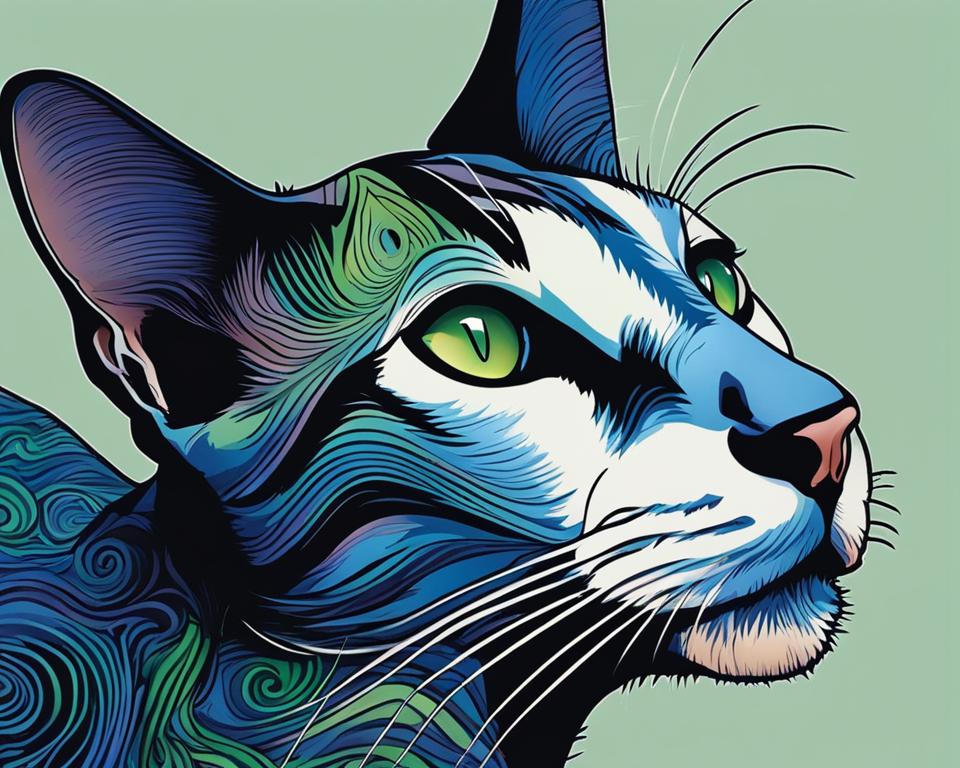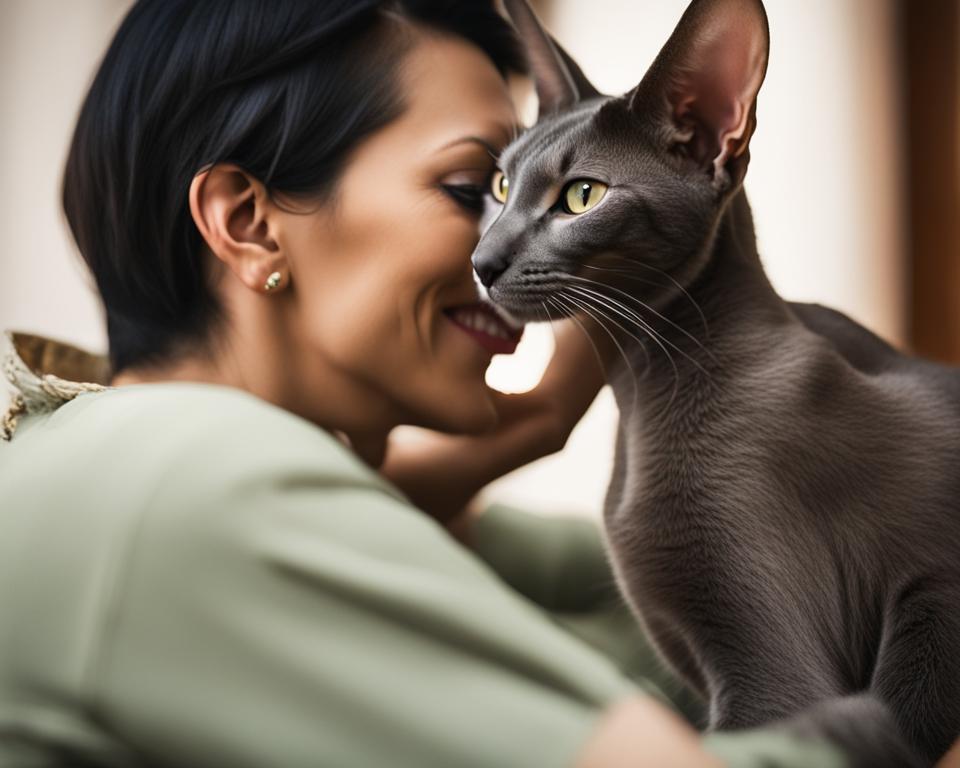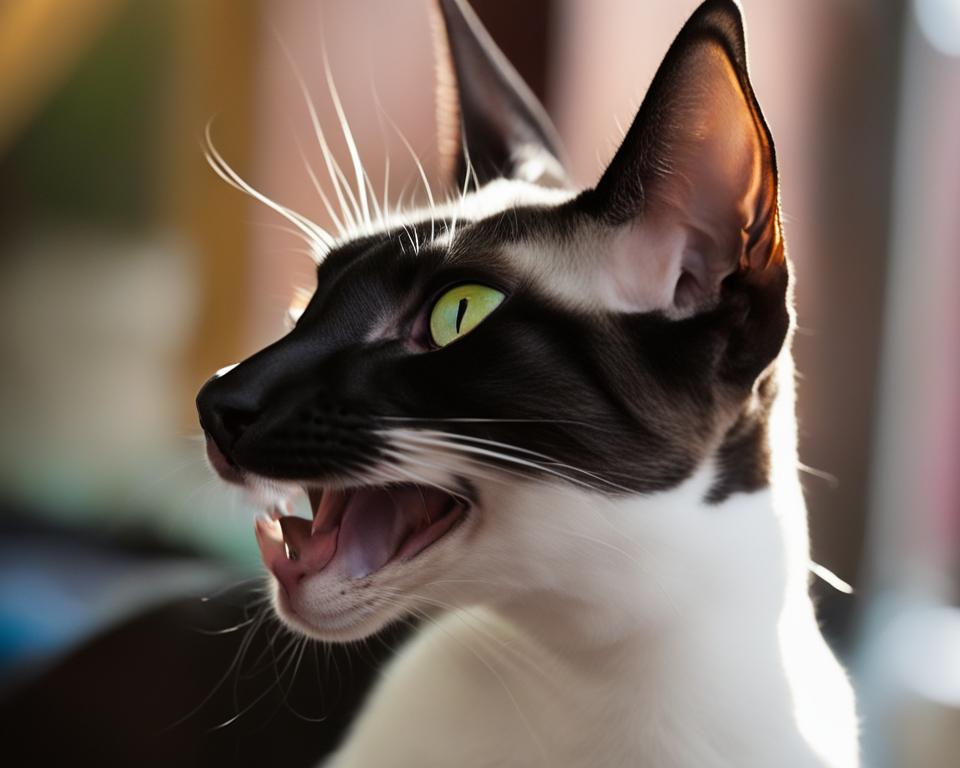Oriental Shorthair cats are known for their unique vocalization behaviors and distinct sounds. Understanding the reasons behind their vocalizations is important for cat owners to better communicate with and meet the needs of their feline friends.
Oriental Shorthair cats use purring as a form of communication, which can vary in pitch, length, volume, and intensity. By paying attention to your Oriental Shorthair’s purring, you can interpret their emotional state correctly and strengthen your bond with them.
Key Takeaways:
- Oriental Shorthair cats have unique vocalization behaviors and distinct sounds.
- Purring is a form of communication for cats and can vary in pitch, length, volume, and intensity.
- The context in which a cat is purring can provide important information about their emotional state.
- Purring has therapeutic benefits for both cats and humans, including promoting healing and reducing stress.
- Pay attention to your Oriental Shorthair’s purring to interpret their emotional state correctly.
Common Types of Purring in Oriental Shorthair Cats
Oriental Shorthair cats, known for their unique vocalization behaviors, have various types of purring sounds that can convey different emotions and needs. Understanding these different types of purring can help cat owners better communicate with and meet the needs of their feline companions.
High-Pitched Purring
One common type of purring in Oriental Shorthair cats is high-pitched purring. This type of purring is often associated with excitement or anxiety. When a cat is feeling playful or anticipates something exciting, their purring may take on a higher pitch. Similarly, when a cat is feeling anxious or fearful, their purring may become high-pitched as a way to express their distress.
Low-Pitched Purring
On the other hand, low-pitched purring in Oriental Shorthair cats is often a sign of contentment and relaxation. When a cat is in a calm and comfortable state, their purring may take on a deeper tone. This type of purring is commonly heard when a cat is being petted or when they are resting peacefully.
It is important to pay attention to the context in which a cat is purring in order to better understand their emotions. While high-pitched purring may indicate excitement or anxiety, low-pitched purring is typically a sign of contentment and relaxation. By observing your Oriental Shorthair’s different types of purring, you can gain insight into their emotional state and provide them with the appropriate care and attention.
Table: Types of Purring in Oriental Shorthair Cats
| Type of Purring | Meaning |
|---|---|
| High-Pitched Purring | Excitement or anxiety |
| Low-Pitched Purring | Contentment and relaxation |
The Science Behind Purring and its Benefits
Oriental Shorthair cats have long fascinated cat lovers with their unique vocalization behaviors. While purring is a common behavior observed in cats, there is more to it than meets the ear. Purring is not just a form of communication for cats, but it also has scientific benefits for both felines and humans.
Research has shown that the vibrations produced by a cat’s purring can have positive effects on their health. Purring has been linked to increased bone density and the promotion of healing in cats. These vibrations stimulate the body’s natural healing mechanisms, aiding in the recovery from injuries or illnesses. Additionally, the act of purring has a calming effect on both cats and humans, reducing stress and anxiety.
Moreover, the frequency of a cat’s purr falls within a therapeutic range that can have beneficial effects on the human body. The vibrations produced by purring have been found to lower blood pressure and heart rate, promoting feelings of relaxation and well-being. In fact, some hospitals and nursing homes have implemented “pet therapy” programs that involve bringing in cats to interact with patients and harness the therapeutic benefits of purring.
| Benefits of Purring for Cats | Benefits of Purring for Humans |
|---|---|
| Increased bone density | Lowered blood pressure |
| Promotion of healing | Reduced heart rate |
| Calming effect | Relaxation and stress reduction |
Understanding the science behind purring can help cat owners appreciate the significance of this behavior. By recognizing the therapeutic benefits of purring, we can better understand and cater to the emotional and physical needs of our Oriental Shorthair cats.

Understanding Your Oriental Shorthair’s Purring as a Sign of Happiness
Oriental Shorthair cats are known for their distinctive vocalization behaviors, and understanding their purring can provide valuable insights into their emotions and well-being. Purring in Oriental Shorthairs is often a sign of happiness and contentment. When a cat is relaxed, has a slow blink or soft eyes, and is kneading with their paws while purring, it indicates that they are happy and comfortable. However, it is important to note that not all purring is a sign of happiness in cats. Excessive or unusual purring can be a sign of discomfort or distress, and it is crucial to observe your cat’s behavior closely and consult a veterinarian if necessary.
Oriental Shorthair cats have a reputation for their vocalization, and understanding their purring as a sign of happiness can help strengthen the bond between cat and owner. By recognizing their contentment, you can ensure that your feline friend’s needs are being met and create a positive and fulfilling environment for them.
To better manage the vocalization of your Oriental Shorthair and promote their happiness, consider the following tips:
- Pay attention to your cat’s body language while purring. A relaxed posture, slow blinking, and kneading are signs of contentment.
- Provide a comfortable and stimulating environment for your cat, with cozy resting spots, toys, and scratching posts.
- Engage in regular playtime and bonding activities with your Oriental Shorthair, such as interactive play sessions and gentle grooming.
- Ensure that your cat is receiving a balanced and nutritious diet to support their overall health and well-being.
- Establish a routine for feeding, playtime, and quiet time to provide a sense of security and predictability for your cat.
By implementing these tips and understanding your Oriental Shorthair’s purring as a sign of happiness, you can create a harmonious and fulfilling relationship with your feline companion.

Tips for Encouraging Healthy Vocalization in Oriental Shorthair Cats
To promote healthy vocalization in your Oriental Shorthair cat, it’s essential to create a comfortable and stimulating environment. Spending quality time with your feline friend is crucial, as it strengthens the bond between you and encourages positive vocalization. Engage in interactive play sessions and provide them with stimulating toys to keep them mentally and physically active.
Grooming your Oriental Shorthair cat is not only an important part of their overall hygiene but also contributes to their well-being. Regular grooming helps prevent matting and keeps their coat healthy and shiny. It also provides an opportunity for bonding and can have a calming effect, reducing excessive vocalization.
It’s important to reward your cat for positive vocalization to reinforce the behavior. When your Oriental Shorthair cat engages in healthy vocalization, offer treats or verbal praise to encourage them. This positive reinforcement helps them associate vocalization with positive experiences.
If your cat exhibits excessive vocalization, it’s essential to consult with a veterinarian. Excessive vocalization can be a sign of underlying health issues or behavioral concerns that need to be addressed. A thorough examination by a veterinarian will help determine the cause and provide appropriate guidance to manage the excessive vocalization effectively.
FAQ
Why do Oriental Shorthair cats vocalize so much?
Oriental Shorthair cats are known for their unique vocalization behaviors. They use vocalization as a means of communication, expressing various emotions and needs.
What do the different types of purring in Oriental Shorthair cats mean?
Oriental Shorthair cats have various types of purring sounds that can convey different emotions and needs. High-pitched purring may indicate excitement or anxiety, while low-pitched purring may indicate contentment and relaxation. The context in which a cat is purring is crucial to understand their emotions.
What are the benefits of purring for cats and humans?
Purring has therapeutic benefits for both cats and humans. The vibrations produced by purring can increase bone density and promote healing in cats. Purring also has a calming effect, reducing stress and anxiety in cats and humans. Some hospitals and nursing homes even have “pet therapy” programs that involve bringing in cats to provide the therapeutic benefits of purring.
What does it mean when my Oriental Shorthair cat is purring?
Purring in Oriental Shorthair cats is often a sign of happiness and contentment. When a cat is relaxed, has a slow blink or soft eyes, and is kneading with their paws while purring, it indicates that they are happy and comfortable. However, not all purring is a sign of happiness in cats, and excessive or unusual purring can indicate discomfort or distress.
How can I encourage healthy vocalization in my Oriental Shorthair cat?
To encourage healthy vocalization in Oriental Shorthair cats, it is important to provide them with a comfortable and stimulating environment. Spending quality time with your cat, providing them with toys and playtime, and giving them proper grooming and attention are essential. Offering treats and rewards for positive vocalization can reinforce the behavior. However, if your cat exhibits excessive vocalization, it is important to consult with a veterinarian to rule out any underlying health issues or behavioral concerns.

Leave a Reply